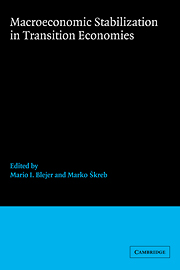Book contents
- Frontmatter
- Contents
- List of Contributors
- Preface
- Introduction Stabilization After Five Years of Reform: Issues and Experiences
- PART I GENERAL STUDIES
- 1 From Plan to Market: Patterns of Transition
- 2 The Great Contractions in Transition Economies
- 3 Enterprise Credit and Stabilization in Transition Economies: Experience with Enterprise Isolation Programs
- 4 Employeeism: Corporate Governance and Employee Share Ownership in Transitional Economies
- PART II COUNTRY STUDIES
- PART III AFTERWORD
- Index
1 - From Plan to Market: Patterns of Transition
Published online by Cambridge University Press: 09 October 2009
- Frontmatter
- Contents
- List of Contributors
- Preface
- Introduction Stabilization After Five Years of Reform: Issues and Experiences
- PART I GENERAL STUDIES
- 1 From Plan to Market: Patterns of Transition
- 2 The Great Contractions in Transition Economies
- 3 Enterprise Credit and Stabilization in Transition Economies: Experience with Enterprise Isolation Programs
- 4 Employeeism: Corporate Governance and Employee Share Ownership in Transitional Economies
- PART II COUNTRY STUDIES
- PART III AFTERWORD
- Index
Summary
INTRODUCTION
The transition from a planned economy to a market economy involves a complex process of institutional, structural, and behavioral change. Formerly communist countries have moved along this transition to varying degrees. This essay places these countries into a comparative perspective. It emphasizes the cornerstone of the early reforms – economic liberalization, for which an index is developed – and its interaction with growth and inflation: How do these outcomes relate to progress with reform? It also considers the macroeconomic and sectoral patterns underlying these interactions.
The findings here help to explain two paradoxes of transition. One is that the attempt to maintain employment and output by fiscal and quasifiscal transfers to enterprises results in larger output declines than a policy of hard budget constraints introduced along with economic liberalization. The other paradox is that the liberalization of prices results in lower inflation than do continued price controls. In both cases, liberalization leads to stabilization in a way that is not selfevident to policy makers accustomed to socialist pricing and output conventions.
The core countries analyzed are 26 in Central and Eastern Europe (CEE) and the former Soviet Union (FSU), plus Mongolia. China and Vietnam are also included for comparative purposes, although these countries are distinctive in many respects. The period covered is 1989 through 1994. The starting point is the last year before the initial postcommunist transitions, although Poland, Hungary, the former Yugoslavia, and China had previously initiated significant reforms and other countries had also taken some reform steps.
- Type
- Chapter
- Information
- Macroeconomic Stabilization in Transition Economies , pp. 17 - 72Publisher: Cambridge University PressPrint publication year: 1997
- 39
- Cited by

